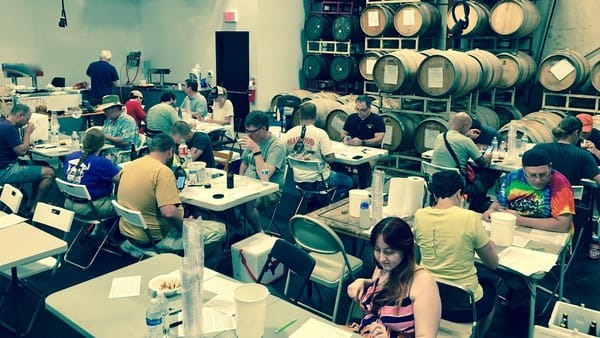Measuring Mash pH in Practice

I see a lot of questions asked about WHEN one should measure mash pH. I thought it would be useful to walk through the steps first and discuss the acid and buffering system of a mash in the real world, as well as some thoughts on a good meter.
Using a quality pH meter is important, as is the calibration, storage and maintenance of the device. Fortunately, we don't need a lab quality meter and the prices of good meters are reasonable. Here are a few recommendations taken from Homebrewtalk.com and Braukaiser's website:
- Choose a meter with resolution and accuracy out to +/- 0.01/0.02 pH units. This may limit your choices to meters over $100. A 0.1 resolution meter maybe enough for mash pH measurement and give more choices under $100. You get what you pay for however.
- Choose a meter that allows for a 2-point calibration. You will need to calibrate 'slope' between 4.01 and 7.01 pH solutions, appropriate pH ranges for brewing.
- Decide if you need Automatic Temperature Correction (ATC). This will add some cost to the meter, but also drop the need for highly accurate temperature measurements along with pH. Temperature and wort pH correlate - ATC helps to compensate
- Choose a meter with replaceable probes. Many bench and pen-style meters allow for probe replacements, and often the probe is the source of problems, and the most delicate part of the instrument.
- Replace your calibration and storage solutions often. They degrade over time and can become contaminated with use.
Many people recommend the Hach Hanna Pocket Pro+ and either the Milwaukee MW101 or MW102. I have the MW102 and have been very happy with its performance. Hanna meters are bought directly from the Hach website, and have a good reputation for support. You can find Milwaukee meters on Amazon - and watch for a sale. Like any good measurement instrument, you get what you pay for. A $30 meter will most likely not give accurate results or last.
I recommend immediately calibrating your meter per the manufacturer's recommendations. This varies meter to meter - so read the instructions correctly. The Milwaukee meter allows for 2-point calibration, but across three possible values, 4.01, 7.01 and 10... so setting the slope should only use the 4.01 and 7.01 solutions, and you skip past the 10 calibration point. Most meters ship with pillow packets of buffers that can be used when mixed with distilled water. The pillows also store very well, and are a good alternative to buying premade solutions.
It is also recommended to perform a stability test. This measures the probe's ability to stay constant in a known pH solution (like the 4.01 buffer or the 7.01 buffer) over time. Ideally you should see little shift in variation and be able to chart the errors. The meters we use are not lab-grade, so there will be swings in the errors. A great article posted by AJ DeLange at Homebrewtalk.com details this process.
All meters should be stored correctly and storage solution changed regularly. This ensures the probes do not dry out. Store the meter inside your house in a stable environment. Don't subject it to large swings in temperature.
Using a meter during brewing
There seems to be some confusion about when to take measurements, and what those measurements actually mean, and steps required to fix a problem, should one arise. My process is fairly straightforward. A 60 minute mash is easy to break into 15 minute or 10 minute segments, starting at the 15 minute mark.
Setup an area that is convenient and gives you some room to work. You will need the following:
- Paper towels or a cloth
- A metal or glass dish that can cool quickly. I use a nest of old metal ceramic coated mixing bowls to create an ice bath. This keeps the bowl chilled and a small one or two ounce sample of hot wort cools very quickly.
- A sampling vessel. I use shot glasses.
- A mesh filter - this is used to remove stray bits of grist.
- pH Calibration solutions and a cup of distilled or RO water for rinsing.
- Something to take notes on... I use the back of my Adjustment Summary sheet printout from Bru'n Water.
I typically take measurements at 15 minutes, 30 minutes and toward the end of lautering (output of wort from the MLT to the BK). I note both the temperature of the wort (MW102 has ATC with a temperature probe) as well as the pH. If the measurement is not where I expect it to be, I will decide if I need to make an adjustment, but generally I will let things ride, and confirm the measurement 5 minutes later. At that point - I will know if I need to stop my mashing cycle and add either acid or alkali.
I never add more than needed to move the pH 0.1 units in either direction. And only when I am well outside the 5.2 - 5.6 mash pH range. Stir extremely well and restart the mash at that point, and I extend my mash period by 15 minutes.
Procedure - mash and sparge:
- Calibrate your meter if you haven't already. Rinse the probe in DI water.
- Remove a small 1-2 ounce amount of hot wort and place it into the cold metal bowl, swirling to cool. When the wort is cool to the touch, it is ready. NEVER put your probe into hot wort - this can seriously damage the probe. Always make measurements with the wort at or near room temperature.
- Pour the cooled sample into a shot glass, filtering through the mesh if needed to remove as much of the grist as possible. Grains sticking to the probe can alter the reading.
- Place the pH probe and thermometer into the sample and wait for the readings to stabilize. This may take a few seconds. Most probes have an indicator for when the sample reading is good.
- Write down the readings and rinse the probe. Place the probe back into storage solution until the next reading is required.
It is a good idea to decide where in your system you will take the measurement, for consistency. I like to sample from the return hose on my RIMS system. Do what is convenient, but apply it consistently through your procedures.
Expectations
I have written before about mash pH being a dynamic system. For most brewers, we are looking to get into a specific range of pH, and tolerate a +/- reading of about 0.02 with a good meter. In reality, the pH of the mash drifts as the buffering capacity of the malts and carbonates are exhausted. This may cause pH to shift up. In some mashes, the pH will drift down. You are looking for the 30 - 45 minute measurements to stabilize at or near your target mash pH. In reality, if you target a mash pH of 5.4, which is the safe middle ground for most beers, you will find readings above and below that mark. A perfect reading of 5.4 at 15 minutes may show that your mash is going to drift away from that mark later. Experience and patience is required. DO NOT PANIC if your readings are not on target! Reacting too soon and adding acid or alkali to control the pH may lead to adding too much and having a more dramatic and potentially harmful impact on the mash.
I like to pre-calculate both an acid and an alkali addition in Bru'n Water so I know that I am adding only enough to theoretically impact the mash 0.1 units in either direction. This prevents me from adding more than necessary, and forces me through planning to be aware of where I should be. Combined with experience, I can make the right decisions. I have seen way too many instances where people respond and attempt to add a bit, measure, add a bit more - and the result is a disaster. Don't waste your time chasing a pH target without a plan.
The Effects of Mash pH
We manage mash pH to make sure optimal enzymatic activity in the malts. Bringing your mash into the proper zone ensures the full conversion and extraction of sugars as well as give the fullest flavor from your malts. Mash temperatures, of course, also impact fermentability and can favor certain characteristics.
I have a goal of getting to conversion as quickly and consistently as possible, which means that my water and mash chemistry must be accurate from the outset. As soon as I mash-in, the grist is hydrating and enzymes are activated and acting on the available starches. As the grain continues to hydrate, more starch is released, as are buffers. At the beginning of the mash, this chemistry is dynamic and chaotic, but will seek a balance. I want this process to stabilize as quickly as possible without intervention through the entire mash, without passing outside of the 5.2 - 5.6 pH window. Your recipe will have a dramatic impact on the change over time in the mash. A recipe heavy in roast and crystal malts will start low and drift up, where a pale ale recipe may start in high and drift down. Experience will show you what to expect.
Checking for conversion
I have stopped using the iodine test for conversion as I can usually smell and taste and see the results. That said, the pH sample is a perfect opportunity to test with iodine. (Google for iodine conversion test) I have also occasionally used a refractometer to measure the increase in gravity to double-check. Many brewers are seeking to shorten their mash times and seeing full conversion in just 10-20 minutes. I find that on my system conversion is complete around the 45 minute mark, however, I continue to mash for the full 60 minutes and deploy a mash out. I find that this aids in lautering and helps with my efficiency, but your mileage may vary.
pH during lautering/sparge
When you sparge, the mash has exhausted most or all its buffering capacity, which makes the sparging liquor's alkalinity an issue. A high pH over 6.0 can extract unwanted tannin from the malt, which typically show as astringent. If you are lautering with RO or DI water, then you can lauter out without concern. A bit of acid can also bring that liquor pH under 6 to make sure that the run off stays under 6.0. When using water with alkalinity - the pH will rise more rapidly as it is introduced to the mash - and you should treat that liquor appropriately with acid. If you do NOT sparge with RO or DI water - you should regularly check your run off pH to ensure it is below 6.0. Otherwise, stopping lautering when the gravity reaches between 1.012 or 1.010 will also help reduce tannin extraction into the kettle. If you are experiencing astringency in your beers - this is a likely place to start.
Mash pH will follow into the kettle, where it is further reduced both by boiling and by dilution of the sparge water. Some brewers also manage this pH, and will add some or all of their minerals into the kettle. This will cause a fairly dramatic reaction as the buffering ability of the wort is diminished. Many books recommend bringing the boil pH to around 5.2 to ensure large fluffy break formation. Chris Colby of BeerandWineJournal.com covers this an article. I have gotten into the habit of adding a very small amount of acid and watching for the large fluffy break formation, rather than relying on mineral additions.
pH of Finished Beers
The yeast will create the proper pH environment for their replication and fermentation phases. There is evidence that boil pH has an effect on the finished beer, and can certainly impact yeast stress. In most cases, you do NOT need to worry about it before fermentation. There are many exceptions - especially sour mash or sour wort derived beers, but even then some specific yeasts and souring bacteria thrive in the low pH environment.
Most beers will finish in the low 4.0-4.4 ph range. You should be willing to explore adding lactic or phosphoric acids to beers to meet specific characteristics. I like my saisons to have a tart finish, and find that a tiny addition of lactic acid (always to taste) to help sharpen up ester expression and cut down on phenols. Other beers, such as stouts may benefit from adding baking soda to sweeten up and emphasize malt characteristics. Many people believe this cuts down some of the sharper roast characteristics that may be undesirable.
Using a pH meter at this point can be very helpful in note taking and ensuring that batch to batch your beers are consistent.




